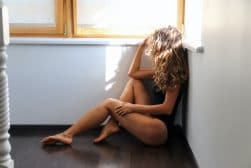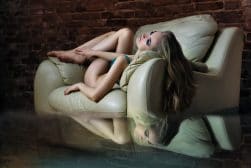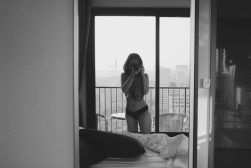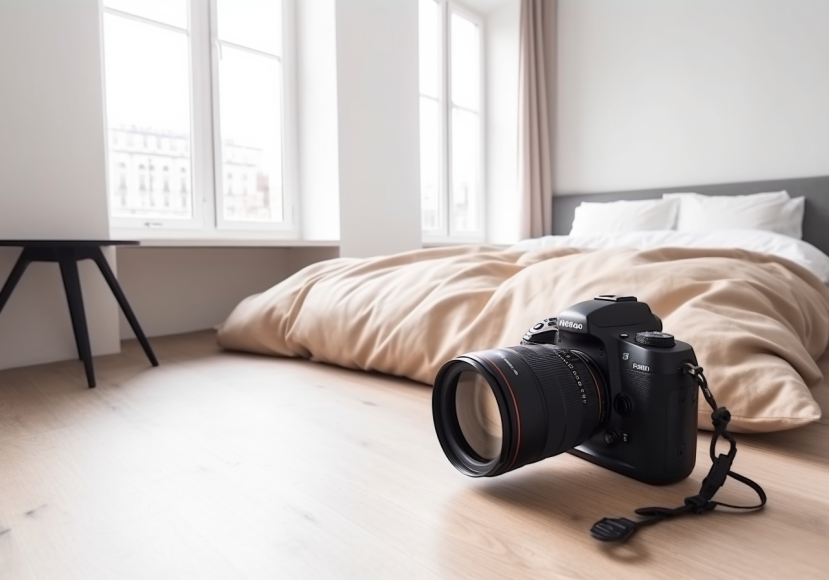
Boudoir Photography Lighting Tips to Create the Right Mood
If there's one element of photography you need to concentrate on to improve your images, it's lighting. This is especially the case with boudoir photography.
Boudoir Photography | Learn | By Mike Cassidy
Boudoir photography has come a long way from its origins as a “hush-hush” intimate art form reserved for the private enjoyment of couples.
Today, it is celebrated as a powerful means of self-expression and body positivity.
As we all know, the essence of boudoir photography lies in capturing the beauty, sensuality, and vulnerability of the subject in a tasteful, artistic manner.
To successfully achieve this, a boudoir photographer must possess a strong understanding of lighting techniques and the ability to create a mood that enhances your client.
Today we’ll take a look at how to use light effectively in boudoir photography, which is vital to help create those stunning images which will help grow your business.
Lighting is everything. The importance of lighting in boudoir photography cannot be overstated. It is the foundation upon which the mood and atmosphere of the image are built.
Lighting determines how the subject’s body is sculpted, the depth and dimension of the scene, and the overall aesthetic of the photograph.
A skilled boudoir photographer understands the nuances of light and uses it to tell a visual story, creating a captivating atmosphere that invites the viewer to look deeper and appreciate the beauty of the moment.
In this article, we’ll explore the fundamentals of lighting in boudoir photography, discussing the advantages and disadvantages of natural and artificial light sources, as well as techniques for creating a soft, flattering light that enhances the subject’s features.
We will also delve into the more advanced aspects of boudoir lighting, covering various setups and equipment choices that can help you achieve the desired mood in your images.
Understanding Light in Boudoir Photography
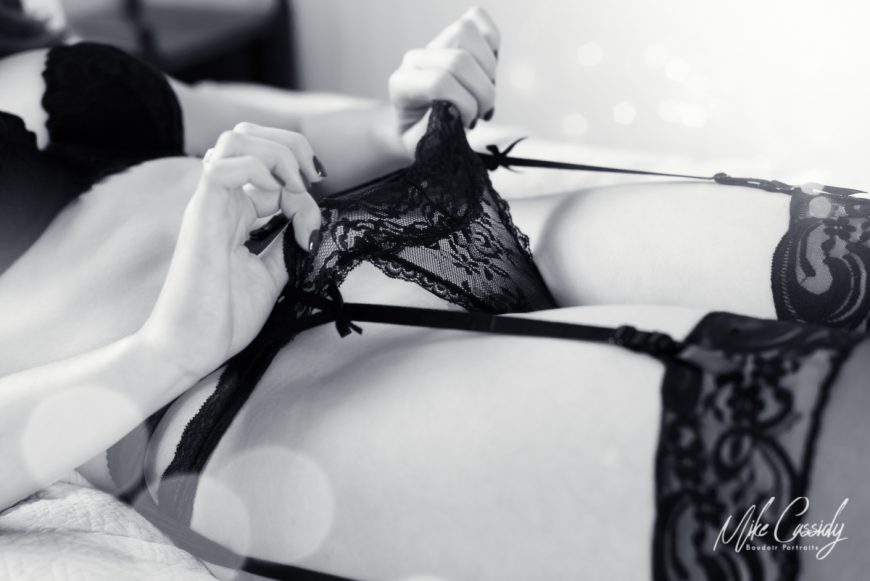
As a boudoir photographer, one of the most important elements you need to master is the understanding of light. The way you manipulate light can make or break a photo session, creating either a stunning, evocative image or a dull, unflattering snapshot.
I can look at a boudoir photo and in a split second, know if the photographer has an understanding of lighting… or not. In this section, we will discuss the differences between natural and artificial light, as well as their respective advantages and disadvantages.
Additionally, we will explore the role of light in setting the mood and atmosphere of your boudoir photography.
Natural Light vs. Artificial Light
Ah, the age-old debate. Natural light, which primarily comes from the sun, provides a soft, warm, and inviting illumination that can be challenging to replicate with artificial sources. It’s always been my preference for the look and feel I want in my photos.
The way sunlight filters through windows, casts soft shadows, and wraps around the subject creates a sense of depth and dimension that enhances the intimacy of the scene.
However, natural light can be very unpredictable and subject to changes in weather conditions, making it essential to adapt and work with what’s available– it’s certainly a challenge.
On the other hand, artificial light, such as continuous lighting or strobes, offers a greater degree of control over the intensity, direction, and color temperature of the illumination.
This allows photographers to fine-tune the lighting to achieve a specific look or mood in their images.
However, artificial lighting can be more challenging to work with, requiring a solid understanding of equipment and techniques to produce a “natural-looking” result– not to mention having to lug around and set up all that gear.
The Role of Light in Setting the Mood
In boudoir photography, the mood and atmosphere are key components that contribute to the overall appeal of the image. The type and quality of light play a crucial role in establishing these elements, as well as enhancing the subject’s features and the intimate nature of the scene.
I’ve always been a “light and airy” type of boudoir photographer, so I’ll be focusing on some lighting concepts I know best.
Importance of Soft, Diffused Lighting: Soft, diffused lighting is a hallmark of boudoir photography, as it creates a flattering, sensual atmosphere that accentuates the subject’s curves and highlights their best features.
How Much Do You REALLY Know About Photography?! 🤔
Test your photography knowledge with this quick quiz!
See how much you really know about photography...

Remember: Boudoir is about “beautiful.” By diffusing the light source, you can minimize harsh shadows and create a more even, gentle illumination that wraps around the subject, emphasizing their natural beauty and allure.
Using Light to Create Depth and Dimension: The strategic use of light can add depth and dimension to your boudoir images, creating a more dynamic and visually engaging composition.
Flat, dull images are not that appealing. By manipulating the angle and intensity of the light, you can sculpt the subject’s body, accentuating their curves and contours and drawing the viewer’s eye through the image.
Highlighting the Subject’s Best Features: A skilled boudoir photographer knows how to use light to emphasize the subject’s best features, while downplaying any perceived imperfections.
This can be achieved through careful control of the light’s direction, intensity, and quality, ensuring that the subject appears at their most alluring and captivating.
Natural Lighting Techniques
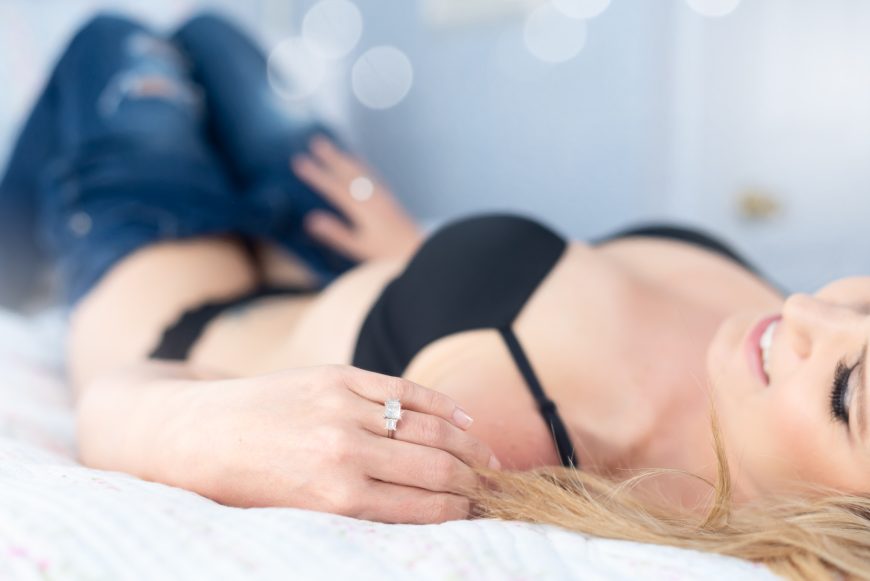
Some may argue that natural light is the only method to photograph boudoir photography. Boudoir photography is intended to be organic, and what’s more organic than natural lighting!
Natural light has a unique, ethereal quality that can imbue boudoir photography with a sense of warmth, depth, and intimacy.
In this section, we will explore various techniques for harnessing the power of natural light, from window light to outdoor settings, to create captivating and evocative boudoir images.
Using Window Light
Window light is a versatile and readily available source of natural light that can be used to create a range of moods and effects in your boudoir photography. Since boudoir photography is photographed in a bedroom setting, usually there are windows present to do the job.
The direction, intensity, and quality of the light can be manipulated by adjusting the position of the subject, the window coverings, and the time of day.
Directional Window Light: Directional window light is an effective technique for creating depth and dimension in your images.
By positioning the subject close to a window and directing them to face the light source, you can create a soft, directional light that sculpts their features and casts gentle shadows across their body.
You’ll see in many of my photos this is exactly what I do! Experiment with different angles and distances to achieve the desired effect.
Backlighting and Silhouettes: Backlighting can be used to create dramatic, high-contrast images that emphasize the subject’s silhouette and form. Backlighting is another one of my favorite techniques.
To achieve this effect, position the subject between the window and the camera, with the light streaming in from behind them. Adjust the camera settings to expose for the subject, allowing the background to brightly fill the scene.
The reverse of this technique is the silhouette. Expose for the background, and you can create a sense of mystery and intrigue, inviting the viewer to imagine what lies beyond the silhouette.
Softening Harsh Sunlight with Curtains or Diffusers: When working with direct sunlight, it’s essential to soften the harsh, intense light to create a more flattering, diffused illumination.
You can achieve this by using curtains, sheers, or other window coverings to filter the light and create a softer, more even glow.
You can see this in many of my photos. Alternatively, you can use a diffuser, such as a white bedsheet or a translucent panel, to scatter the light and reduce its intensity.
Outdoor Boudoir Photography
Alright, I’ll talk about it, but as you know, there is no such thing as “outdoor boudoir.” 😂 While indoor settings are more common for boudoir photography, outdoor locations can provide a unique and enchanting backdrop for your images.
By harnessing the power of natural light, you can create stunning, atmospheric compositions that celebrate the beauty of both your subject and the surrounding environment.
Golden Hour: The golden hour, which occurs shortly after sunrise and before sunset, is a magical time for outdoor boudoir photography.
The warm, golden light casts a soft, flattering glow on the subject and adds a sense of depth and dimension to the scene. By shooting during this brief window of time, you can create images that evoke a sense of warmth, romance, and intimacy.
Overcast Days: Overcast days provide a natural softbox effect, with the clouds acting as a giant diffuser that scatters and softens the sunlight.
This creates a soft, even light that minimizes shadows and highlights, making it ideal for boudoir photography. Embrace the moody, atmospheric nature of an overcast day to create images with a unique, ethereal quality.
Open Shade: Open shade is another effective technique for harnessing natural light in outdoor boudoir photography.
By positioning your subject in the shade of a tree or building, you can protect them from the harsh, direct sunlight while still capturing the soft, ambient light that filters through.
This technique can be a little tricky, but can create a balanced, flattering light that showcases your subject’s natural beauty and highlights the details of the surrounding environment.
Artificial Lighting Techniques
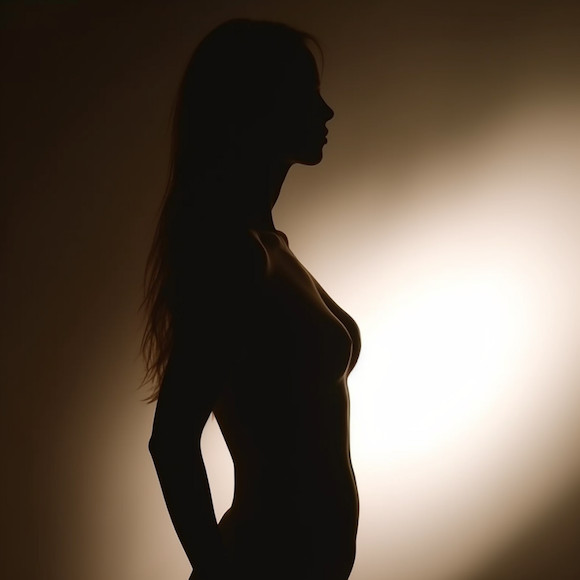
While natural light can produce stunning results in boudoir photography, artificial lighting offers a greater degree of control and versatility. You may find yourself working in a location with poor natural lighting, or with a client who may only be available in the evening.
Sometimes you just have to do it! In this section, we will delve into various artificial lighting techniques and equipment choices, empowering you to create the perfect mood and atmosphere in your boudoir images, regardless of the available natural light.
Choosing the Right Equipment
The type of artificial lighting equipment you choose can have a significant impact on the quality and mood of your boudoir photographs. From continuous lighting to strobes, and a variety of light modifiers, it’s essential to select the right tools for your desired outcome.
There is no one “right” or “best” solution here, as I always note a lot of this is personal preference.
Continuous Lighting vs. Strobes:
Continuous lighting, such as tungsten lights or the somewhat newer system of LED panels provide a constant source of illumination, making it easier to visualize the final result and adjust the lighting as needed.
However, continuous lighting, especially tungsten lights, can generate heat and may not be as powerful as strobes, which emit a burst of light when triggered by the camera.
Strobes, or flash units, offer more control over the intensity and duration of the light but require a deeper understanding of lighting techniques and camera settings to achieve the desired effect.
One isn’t better than the other. On a day I’m working when I know it is going to be super storm-cloudy and dark, LEDs are a great way to simulate natural lighting. My thoughts always turn to what will be the smallest and less intrusive option for my clients.
Softboxes, Umbrellas, Etc.:
Light modifiers are essential tools for shaping and controlling artificial light in boudoir photography. Softboxes, which consist of a light source enclosed in a box with reflective interior walls and a diffusion panel, create a soft, even light that mimics the look of natural window light.
Umbrellas, which can be used in a reflective or shoot-through configuration, offer a more portable and versatile option for diffusing and spreading light.
Typically, strobe lighting is a harsh light, and these modifiers are needed in boudoir photography to soften the light to keep the feel of your images in “beauty mode.” You can experiment with what works best for your look.
Creating a Flattering Light Setup
The key to successful artificial lighting in boudoir photography lies in creating a flattering, mood-enhancing setup that enhances the subject’s natural beauty and evokes the desired atmosphere.
Keep in mind, for this particular post we’re discussing more traditional boudoir with a soft lighting scenario.
This may involve using one, two, or even three light sources, depending on the complexity of the scene and the desired effect (and how much gear you feel like dealing with.)
One-Light Setup:
A one-light setup can produce stunning results in boudoir photography, particularly when combined with a large, soft light source and a reflector to fill in any unwanted shadows.
Position the main light at a 45-degree angle to the subject, either above or level with their face, and use a reflector on the opposite side to bounce light back onto the subject and soften any shadows. Simple and yet effective.
Multiple Light Setups:
A two-light setup can add greater depth and dimension to your boudoir images by providing both a main light and a fill or rim light.
The main light, typically a large softbox or umbrella, should be positioned at a 45-degree angle to the subject.
In contrast, the fill or rim light can be placed on the opposite side, either behind or to the side of the subject, to add highlights and separate them from the background.
If you feel like even getting fancier-schmancier you can even use three-light setups. A three-light setup allows for even greater control over the lighting and mood of your boudoir images.
In addition to the main light and fill or rim light, a third light can be used as a background light to create depth and separation between the subject and the backdrop.
Experiment with different positions and intensities for each light to achieve the desired effect and mood.
By mastering both natural and artificial lighting techniques, you can elevate your boudoir photography to new heights, creating stunning, evocative images that celebrate the beauty, sensuality, and vulnerability of the human form.
With practice, experimentation, and a keen understanding of light’s transformative power, you can harness its potential to craft visual stories that captivate, inspire, and leave a lasting impression.
Tips for Successful Boudoir Lighting

Achieving the perfect lighting for your boudoir photography can be a complex and nuanced process, requiring a deep understanding of light and its effects on the subject and environment.
Additionally, it’s not something you want to be experimenting with while working with a client. In this section, I will share some essential tips for successful boudoir lighting, drawn from my own experiences and expertise as a professional boudoir photographer.
Understand Your Subject
One of the most critical aspects of successful boudoir lighting is understanding your subject’s unique features and preferences. Take the time to get to know your subject before the shoot, discussing their goals, expectations, and any areas of concern.
This will help you tailor your lighting setup to accentuate their best features, create a flattering silhouette, and instill a sense of confidence and comfort during the session.
Experiment with Different Lighting Setups
There is no one-size-fits-all approach to boudoir lighting; the ideal setup will vary depending on the subject, the environment, and the desired mood.
Don’t be afraid to experiment with different lighting setups and techniques, from window light to strobes, and various light modifiers.
By trying new approaches and pushing the boundaries of your comfort zone, you can discover creative and innovative ways to use light to tell a visual story and create captivating boudoir images.
Pay Attention to Shadows
Shadows can be just as important as lighting in boudoir photography. I always think of mastering lighting as the first step. Mastering the shadows, however, is what is needed to bring you to Jedi level work.
Shadows play a crucial role in boudoir photography, helping to create depth, dimension, drama, and a sense of intimacy. Be mindful of the shadows cast by your lighting setup, adjusting the angle and intensity of the light as needed to achieve the desired effect.
Remember, shadows can be used to emphasize the subject’s curves and contours, but they can also draw attention to areas of concern if not managed carefully.
Balance Ambient and Artificial Light
When working with a combination of natural and artificial light sources, it’s essential to strike a balance between the two. Despite what you may think– it’s certainly fine to use a balance of both in your work.
My particular preference is to strive to create images where you can’t tell where one ends…and the other begins. (Again, Jedi level stuff.) Too much artificial light can overpower the soft, warm glow of natural light, while relying solely on ambient light may not provide the desired level of control and flexibility.
Experiment with different ratios of ambient to artificial light, adjusting your camera settings and lighting equipment as needed to create a harmonious, flattering illumination.
Don’t Forget Post-Processing
I learned long ago that I hated editing photos. How do you minimize that? Well, get it right the first time.
While capturing the perfect lighting in-camera is always the goal, it’s essential to remember that post-processing can be a powerful tool for refining and enhancing your boudoir images.
Subtle adjustments to exposure, contrast, and color balance can help to emphasize the mood and atmosphere created by your lighting setup, ensuring that the final image is a true representation of your artistic vision.
By incorporating these tips and techniques into your boudoir photography practice, you can harness the transformative power of light to create evocative, stunning images that celebrate the beauty, sensuality, and vulnerability of your subjects.
With dedication, patience, and a willingness to experiment, you can elevate your boudoir lighting skills and craft visual stories that captivate, inspire, and leave a lasting impression.
Conclusion
As a boudoir photographer, understanding and mastering the art of lighting is essential to creating powerful, emotive images that capture the essence of your subjects and evoke the desired mood.
With a diverse range of techniques and tools at your disposal, you can craft unique, captivating compositions that showcase the beauty, vulnerability, and sensuality of the human form.
One of the most important aspects of boudoir photography is establishing a connection with your subject and fostering a comfortable, trusting environment.
By taking the time to understand their needs, preferences, and concerns, you can tailor your lighting approach to create a flattering, confidence-boosting experience that celebrates their individuality and self-expression.
Never underestimate the value of experimentation and growth. Boudoir photography is an ever-evolving art form, with countless opportunities to explore new techniques, styles, and creative approaches.
By pushing the boundaries of your comfort zone and challenging yourself to try new lighting setups, you can continually hone your skills and develop a unique, distinctive visual language.
In the end, the most effective boudoir lighting is that which serves the story you wish to tell and enhances the emotional connection between the viewer and the subject.
By combining technical expertise with artistic intuition and a deep understanding of your subject’s needs, you can create evocative, compelling images that resonate on a profound, emotional level.
Embrace the journey of mastering boudoir photography lighting, and allow it to inform and inspire your artistic vision.
Through dedication, practice, and a willingness to learn, you can unlock the full potential of light as a storytelling tool, crafting visual narratives that captivate, inspire, and leave a lasting impression on both your subjects and your audience.

Check out these 8 essential tools to help you succeed as a professional photographer.
Includes limited-time discounts.





